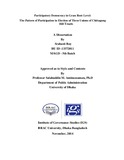| dc.contributor.advisor | Aminuzzaman, Professor Salahuddin M. | |
| dc.contributor.author | Roy, Srabasti | |
| dc.date.accessioned | 2015-03-06T06:14:34Z | |
| dc.date.available | 2015-03-06T06:14:34Z | |
| dc.date.copyright | 2014 | |
| dc.date.issued | 2014-11 | |
| dc.identifier.other | ID 13372011 | |
| dc.identifier.uri | http://hdl.handle.net/10361/4058 | |
| dc.description | This thesis is submitted in partial fulfillment of the requirements for the degree of Masters of Arts in Governance and Development, 2014. | en_US |
| dc.description | Cataloged from PDF version of thesis report. | |
| dc.description | Includes bibliographical references. | |
| dc.description.abstract | Participatory democracy situates by this concept that, every citizen is political actor and
participation in election is political right of a citizen. Participatory democracy is crucial for
empowerment of marginal people. The political culture and social practices are refined in
participatory democracy where every citizen acts dynamic role in the governance process. The
primary institutional arrangement of the participatory democracy is election (John, 2005).
‘Election through franchises’ and ‘Right to Vote’ is the fundamental aspect of political
participation. The voting is linked with sound democratic process and declining of voting rates
express as deficit of democracy. There are several studies, where demographic attributes,
psychological motivations, and social networks have been found as factors of measuring of
voting and other form of political participation.
The imitation of participatory democracy in grass root level of Bangladesh began by political
decentralization and UPs are particular local government institutions preside by election as
political institutions. The UPs are consisting of elected representatives of local units. In this
study to ascertain the strength of political participation, a diminutive locality and its election
participation pattern has been chosen where diverse pattern of demographic characteristics and
in general geopolitical situation is prevailed.
The Chittagong Hill Tracts (CHT) is area with 5,093 square miles (13,295 square kilometer),
which constitutes about 10 percent of the total area of Bangladesh. The Chittagong Hill Tracts
comprises with three districts- Rangamati, Khagrachri and Bandarban. The geographical
position of Hill Tracts is different from other part of Bangladesh. In this study the Belaichari
Upazilla(Sub-district) of Rangamati district has been chosen for research. There are seven
minor ethnic communities in this locality who are - Chakma, Marma, Tripura, Phankho,
Tanchangya, Bowm, and Kheyang. The demographic characteristics of different ethnic
communities’ respondents’ of the Bilaichari Upazilla include - language, religion, customs and
tradition. Practically the spotlight of the study is limited to three unions of Belaichari Upazila
and four minor ethnic communities’ respondent interviewed for the study. The varied minor
ethnics’ demography and individual cultural traditions of each minor community’s of the study
area explores the scope to discover the community engagement in political participation. In
this study socio economical condition, social trend, traditions and political ambience of the
study area has been considered to determine the pattern of people participation.
The Circle Chief, the Headman and the Karbari are traditional social institutions in Chittagong
Hill Tracts, which are prevailing in Hill Tracts from British period. The present roles of the
traditional leaders are to collection the rent of land on behalf of government and they are
assigned by the government for resolving the social disputes. There are 68 traditional leaders in
the study area and eight traditional leaders have been interviewed in consent to ascertain their
vulnerabilities and potentialities in societal democratic process.
The study noticed the external and internal factors where diverse pattern of participation is
affecting by several intangible factors. The study will endow with perceived discussion about
political and historical site of CHT. The research work addressed the role of social institutions,
how those are influencing on political participation, especially on election participation. | en_US |
| dc.description.statementofresponsibility | Srabasti Roy | |
| dc.language.iso | en | en_US |
| dc.publisher | BRAC University | en_US |
| dc.rights | BRAC University dissertation are protected by copyright. They may be viewed from this source for any purpose, but reproduction or distribution in any format is prohibited without written permission. | |
| dc.subject | Governance and development | en_US |
| dc.subject | Participatory democracy | en_US |
| dc.title | Participatory democracy in grass root level : the pattern of participation in Election of three Unions of Chittagong Hill Tracts | en_US |
| dc.type | Thesis | en_US |
| dc.contributor.department | BIGD, BRAC University | |
| dc.description.degree | M. Governance and Development | |

